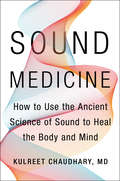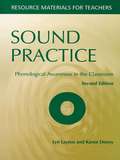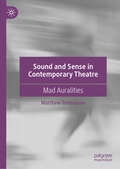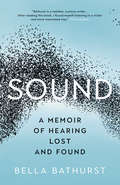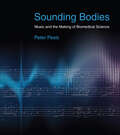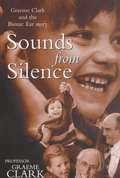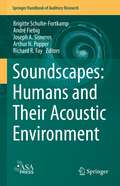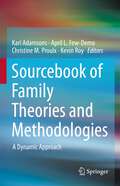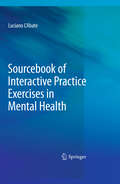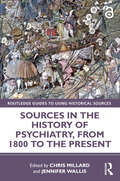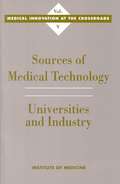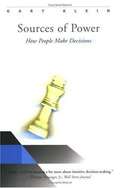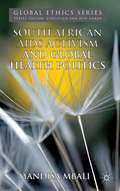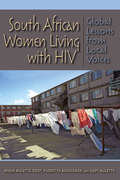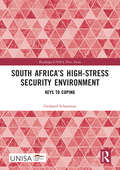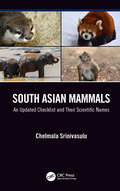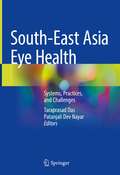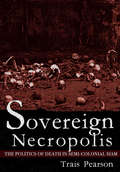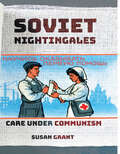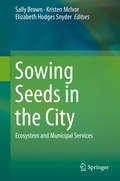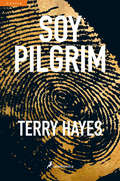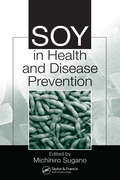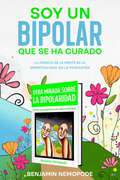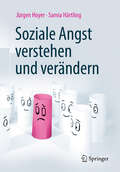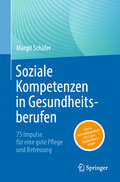- Table View
- List View
Sound Medicine: How to Use the Ancient Science of Sound to Heal the Body and Mind
by Kulreet Chaudhary M.D.From a leading neurologist, neuroscientist and practitioner of Ayurvedic medicine, comes a rigorous scientific investigation of the healing power of sound, showing readers how they can use it to improve their mental and physical wellbeing. Why does a baby’s cry instantaneously flood a mother’s body with a myriad of stress hormones? How can a song on the radio stir up powerful emotions, from joy to anger, regret to desire? Why does sound itself evoke such primal and deeply felt emotions?A vibration that travels through air, water and solids, sound is produced by all matter, and is a fundamental part of every species’ survival. But there is a hidden power within sound that has only just begun to be investigated. Sound Medicine takes readers on a journey through the structure of the mouth, ears, and brain to understand how sound is translated from acoustic vibrations into meaningful neurological impulses. Renowned neurologist and Ayurvedic expert Dr. Kulreet Chaudhary explains how different types of sound impact the human body and brain uniquely, and explores the physiological effects of sound vibration, from altering mood to healing disease.Blending ancient wisdom with modern science, Dr. Chaudhary traces the history of sound therapy and the use of specific mantras from previously unknown texts—traced back to the Siddhas, a group of enlightened yogis who created a healing tradition that served as the precursor to Ayurvedic medicine—to explain the therapeutic application of sounds for a wide range of conditions. Sound Medicine offers practical, step-by-step lessons for using music and mantras, whether you’re a beginner or searching for a more advanced practice, to improve your health in body, mind, and spirit.
Sound Practice: Phonological Awareness in the Classroom (Resource Materials For Teachers Ser.)
by Lyn Layton Karen DeenyThe second edition of Sound Practice looks afresh at how young children can be helped to discover basic facts about an alphabetic spelling system, within the context of their developing spoken language. It examines why children might fail to understand letter-sound links; the origins of severe and persistent difficulties with achieving functional literacy skills; and developmental processes underpinning the areas of learning identified in national initiatives for promoting children's learning. The book also discusses the need for differentiation strategies to respond to individual children's learning needs within national initiatives, and techniques and approaches that can be effectively applied to fulfil curriculum objectives. Phonological awareness is the key to independent literacy and must be explicitly tackled in the classroom in order to promote early reading and writing and to address written language difficulties in older children. This book is a suitable resource for initial and in-service training for teachers and teaching assistants and includes photocopiable worksheets.
Sound and Sense in Contemporary Theatre: Mad Auralities
by Matthew TomkinsonThis book is among the first to consider the subject of mad auralities in theatre and performance, asking: what does it mean to hear and listen madly? Drawing widely upon mad studies, critical disability studies, theatre studies, sound studies, queer studies, and critical race theory, it seeks to explore the theatrical relationship between sound and mental health differences by examining a range of case studies in which audience members are immersed in auditory simulations of madness. Ultimately, however, this critical study investigates the shortcomings of simulation as a representational practice, in keeping with the critical tradition of disability studies and mad studies.
Sound: A Memoir of Hearing Lost and Found
by Bella Bathurst&“A moving and fascinating book about sound and what it means to be human&” from the Somerset Maugham Award–winning author of The Lighthouse Stevensons (Financial Times). In this surprising and moving book, award-winning writer Bella Bathurst shares the extraordinary true story of how she lost her hearing and eventually regained it and what she learned from her twelve years of deafness. Diving into a wide-ranging exploration of silence and noise, she interviews psychologists, ear surgeons, and professors to uncover fascinating insights about the science of sound. But she also speaks with ordinary people who are deaf or have lost their hearing, including musicians, war veterans, and factory workers, to offer a perceptive, thought-provoking look at what sound means to us. If sight gives us the world, then hearing—or our ability to listen—gives us our connections with other people. But, as this smart, funny, and profoundly honest examination reveals, our relationship with sound is both more personal and far more complex than we might expect. &“Bathurst is a restless, curious writer . . . After reading this book, I found myself listening in a richer and more interested way.&” —The Guardian &“A hymn to the faculty of hearing by someone who had it, lost it and then found it again, written with passion and intelligence . . . terrifying, absorbing and ultimately uplifting.&” —Literary Review &“Bathurst&’s affecting memoir will enlighten and educate.&” —Publishers Weekly &“A memoir of hearing loss and what the author learned . . . through her unexpected recovery from it. A good writer knows material when it presents itself, and Bathurst is a very good writer.&” —Kirkus Reviews
Sounding Bodies: Music and the Making of Biomedical Science
by Peter PesicThe unfolding influence of music and sound on the fundamental structure of the biomedical sciences, from ancient times to the present.Beginning in ancient Greece, Peter Pesic writes, music and sound significantly affected the development of the biomedical sciences. Physicians used rhythmical ratios to interpret the pulse, which inspired later efforts to record the pulse in musical notation. After 1700, biology and medicine took a &“sonic turn,&” viewing the body as a musical instrument, the rhythms and vibrations of which could guide therapeutic insight. In Sounding Bodies, Pesic traces the unfolding influence of music and sound on the fundamental structure of the biomedical sciences. Pesic explains that music and sound provided the life sciences important tools for hearing, understanding, and influencing the rhythms of life. As medicine sought to go beyond the visible manifestations of illness, sound offered ways to access the hidden interiority of body and mind. Sonic interventions addressed the search for a new typology of mental illness, and practitioners used musical instruments to induce hypnotic states meant to cure both psychic and physical ailments. The study of bat echolocation led to the manifold clinical applications of ultrasound; such sonic devices as telephones and tuning forks were used to explore the functioning of the nerves. Sounding Bodies follows Pesic&’s Music and the Making of Modern Science and Polyphonic Minds to complete a trilogy on the influence of music on the sciences. Enhanced digital editions of Sounding Bodies offer playable music and sound examples.
Sounds from Silence: Graeme Clark and the Bionic Ear Story
by Graeme ClarkThe author's interest in the development of improved hearing devices for the deaf arose from his interactions with his own father, who lost his hearing. Having worked in a pharmacy, Graham Clark developed a keen interest in pursuing a medical degree. His research and tenacity led him to develop the multiple contact bionic ear. The book takes us on a journey with the author through his life and his perseverance to develp this device.
Soundscapes: Humans and Their Acoustic Environment (Springer Handbook of Auditory Research #76)
by Arthur N. Popper Richard R. Fay Joseph A. Sisneros Brigitte Schulte-Fortkamp André FiebigThe concept of the “Soundscapes” includes all of the sounds in one’s environment and focuses not only on the sounds itself. Instead, it focuses on the interrelationships between person and activity and place, both in space and time. Soundscape also include influences on the acoustic environment through auditory sensation, its interpretation, and the responses to the acoustic environment in context. The conceptual framework of Soundscape describes the “process of perceiving or experiencing and/or understanding an acoustic environment, highlighting general concepts and their relationships: context, sound sources, acoustic environment, auditory sensation, interpretation of auditory sensation, responses, and outcomes” (International Organization for Standardization, ISO 12913-1:2014 Acoustics Soundscape Part Definition and Conceptual Framework, ISO, Geneva, 2014).With soundscape, one achieves a deeper understanding of acoustic environment and its effects on people. The ISO standard 12931-1 on soundscape provides an important, and rigorous, distinction in the use of “Soundscape.” But, it is recognizable that some individuals, particularly planners, designers, lay persons, and even those primarily interested in management of the acoustic environment through environmental noise control, will find it convenient to use “Soundscape” as a synonym for the physical acoustic environment.When it comes to noise management and urban planning, soundscape research has the potential to promote healthy urban environments by sharing and incorporating the significant knowledge of all concerned parties. Understandably, this shows that the communication with regard to noise management has to be forced to guarantee that the specifics of Soundscapes (i.e., the relevance of perception) are seriously considered alongside the whole.This book will bridge the gap between soundscape theory and practice and therefore it will be different from our earlier publications as “Soundscape and the built environment” (ed. by J. Kang and B. Schulte-Fortkamp CRC Press, Taylor and Francis Group, Boca Raton, Fl 2016) and also from the respective Special Issues on Soundscapes in 2012 in The Journal of the Acoustical Society of America (ed. by B. Schulte-Fortkamp and J. Kang), and also the Special Issue in Acta Acustica 2006 *(ed. by B. Schulte-Fortkamp and D. Dubois), and the E-book on soundscape This volume will be driven by the difficult process of standardization of Soundscape and its evaluation procedures. The main goal of the proposed volume is to present and review the developments in Soundscape, reflecting the standardization procedure and the diverse inputs. the needs in management and planning in urban acoustic environments, the book will also focus on the difficulties, as well as the solutions, in interdisciplinary grounded communication, that is, on the one hand, related to science, but on the other to application, that needs guidance.
Sourcebook of Family Theories and Methodologies: A Dynamic Approach
by Kevin Roy Kari Adamsons April L. Few-Demo Christine M. ProulxThis sourcebook is an unparalleled resource in the field of family science. It provides a comprehensive overview of both traditional and contemporary theories and methodologies to promote a greater understanding of increasingly complex family realities. It focuses on broad developments in research design and conceptualization, while also offering a historical perspective on developments in family science over time, particularly emerging theories from the past several decades. Each chapter summarizes and evaluates a major theory or methodological approach in the field, delving into its main principles; its debates and challenges; how it has evolved over time; its practical uses in policy, education, or further research; and links to other theories and methodologies. In highlighting recent research of note, chapters emphasize the potential for innovative future applications.Key areas of coverage include:· Risk and resilience, family stress, feminist, critical race, and social exchange theories.· Ambiguous loss, intersectionality, Queer, and family development theory.· Life course framework.· Biosocial theory and biomarker methods.· Symbolic interactionism.· Ethnography.· Mixed methods, participatory action research, and evaluation.
Sourcebook of Interactive Practice Exercises in Mental Health
by Luciano L'AbateAs a primary or an adjunct mental health therapy, written practice exercises have proven an effective, low-cost way for clients to transfer gains made in therapy to the challenges of daily life and relationships. These interactive workbooks expand on earlier self-help and distance writing methods along a continuum of healing approaches, from the proactive and preventive to the therapeutic and rehabilitative. But despite their appeal, large-scale access to high-quality materials hasn't always been readily available--until now. The Sourcebook of Interactive Practice Exercises in Mental Health gives professionals a library of replicable, evidence-based, clinically robust protocols and workbooks for a broad range of clinical and non-clinical conditions, suitable for individuals, couples, and families. Luciano L'Abate places practice exercises in the context of current mental health and technological advances, offering guidelines for administration, helpful case studies, and caveats for those new to this type of intervention, and features a wealth of complete protocols in these major areas: psychological disorders from the DSM-IV, including depression, anxiety, phobias, and PTSD, couple and family concerns, from intimacy to domestic violence to children's adjustment to divorce, lifelong learning: assertiveness, emotional competence, social skills, and more, family support skills: preparation for marriage, parenthood, and adoption´, plus exercises derived from widely-used psychological tests (e.g., the Beck Depression Inventory, the MMPI), behavior lists, and others. Clinical psychologists, mental health professionals, and psychotherapists will find the Sourcebook of Interactive Practice Exercises in Mental Health a therapeutic treasure chest filled with new approaches to intractable issues or unreachable clients, new means of viewing typical problems, even new ways for talk therapy to work with words.
Sources in the History of Psychiatry, from 1800 to the Present (Routledge Guides to Using Historical Sources)
by Chris MillardThis book offers a general introduction to historical sources in the history of psychiatry, delving into the range of sources that can be used to investigate this dynamic and exciting field. The chapters in this volume deal with physical sources that might be encountered in the archive, such as asylum casebooks, artwork, material artefacts, post-mortem records, more general types of source including medical journals, literature, public enquiries, and key themes within the field such as feminist sources, activist and survivor sources. Offering practical advice and examples for the novice, as well as insightful suggestions for the experienced scholar, the authors provide worked-through examples of how various source types can be used and exploited and reflect productively on the limits and constraints of different kinds of source material. In so doing it presents readers with a comprehensive guide on how to ‘read’ such sources to research and write the history of psychiatry. Methodically rigorous, clear and accessible, this is a vital reference for students just starting out within the field through to more experienced scholars experimenting with new and unfamiliar sources in the history of medicine and history of psychiatry more specifically.
Sources of Medical Technology: Universities and Industry
by Committee on Technological Innovation in MedicineEvidence suggests that medical innovation is becoming increasingly dependent on interdisciplinary research and on the crossing of institutional boundaries. This volume focuses on the conditions governing the supply of new medical technologies and suggest that the boundaries between disciplines, institutions, and the private and public sectors have been redrawn and reshaped. Individual essays explore the nature, organization, and management of interdisciplinary R&D in medicine; the introduction into clinical practice of the laser, endoscopic innovations, cochlear implantation, cardiovascular imaging technologies, and synthetic insulin; the division of innovating labor in biotechnology; the government- industry-university interface; perspectives on industrial R&D management; and the growing intertwining of the public and proprietary in medical technology.
Sources of Power: How People Make Decisions
by Gary A. KleinSince 1985, Klein has conducted fieldwork to find out how people tackle challenges in difficult, nonroutine situations. Sources of Power is based on observations of humans acting under such real-life constraints as time pressure, high stakes, personal responsibility, and shifting conditions. The professionals studied include firefighters, critical care nurses, pilots, nuclear power plant operators, battle planners, and chess masters. Each chapter builds on key incidents and examples to make the description of the methodology and phenomena more vivid. In addition to providing information that can be used by professionals in management, psychology, engineering, and other fields, the book presents an overview of the research approach of naturalistic decision making and expands our knowledge of the strengths people bring to difficult tasks.
South African AIDS Activism and Global Health Politics
by Mandisa MbaliSouth Africa has the world's largest number of people living with HIV. This book offers a history of AIDS activism in South Africa from its origins in gay and anti-apartheid activism to the formation and consolidation of the Treatment Action Campaign (TAC), including its central role in the global HIV treatment access movement.
South African Women Living with HIV
by Anna Aulette-Root Floretta Boonzaier Judy AuletteBased on interviews with women who are HIV positive, this sobering pandemic brings to light the deeply rooted and complex problems of living with HIV. Already pushed to the edges of society by poverty, racial politics, and gender injustice, women with HIV in South Africa have found ways to cope with work and men, disclosure of their HIV status, and care for families and children to create a sense of normalcy in their lives. As women take control of their treatment, they help to determine effective routes to ending the spread of the disease.
South Africa’s High-Stress Security Environment: Keys to Coping (ISSN)
by Gerhard SchoemanThis book presents valuable insights into the realities faced by security personnel as they deal with life-threatening situations in a high-stress security environment. The causes and consequences of stress are explored, followed by a comprehensive discussion of coping strategies and the negative consequences of not being able to cope effectively. In this book, a scientifically tested accessible model is also developed, which provides a visual overview of the stress management process and captures the flow between stressors, personality, and coping strategies.South Africa's High-Stress Security Environment is a helpful guide for anyone who wants to gain a wider understanding and appreciation of the challenges and the courage of security personnel – which we often take for granted.Print edition not for sale in Sub Saharan Africa.
South Asian Mammals: An updated Checklist and Their Scientific Names
by Chelmala SrinivasuluThis book is an up-to-date comprehensive resource on the names (scientific, English and vernacular) of the mammals of South Asia. This work is first of its kind that deals with explanation of names of mammals at the species and subspecies level.
South-East Asia Eye Health: Systems, Practices, and Challenges
by Taraprasad Das Patanjali Dev NayarThe book covers all aspects of eye health in South-East Asia from public health to health system to education to industry in 6 sections. The World Health Organization (WHO) South-East Asia region comprises of 11 countries - Bangladesh, Bhutan, DPR Korea, India, Indonesia, Maldives, Myanmar, Nepal, Sri Lanka, Thailand and Timor-Leste. This region is home to 26% of world population; there is a disproportionate amount of blindness (30.6%) and visual impairment (36%).This is a first of its kind book that discusses common conditions of visual impairment and blindness in the South-East Asia region. In addition, the book documents the current eye care industry in the region and the contribution of all eye health INGOs in eye care program planning and service delivery for many decades. Majority of the countries in the South-East Asia region are categorized in ‘middle-income country’ group. This book discusses the common challenges in these countries such as, suboptimal public expenditure in health, acute shortage of skilled eye health workforce, and rudimentary health industry. The book covers the following 6 sections:1. Geographic description and health indices of the region2. Health system evolved over years, including universal eye health, health financing and health management information system (HMIS)3. Common eye problems including non-communicable disease NCD (and diabetic retinopathy), neglected tropical disease NTD (and Trachoma)4. Health workforce in the region that includes ophthalmologists, optometrists, and allied ophthalmic personnel5. Eye health support in the region of 13 international non-government organizations (INGOs) working for decades6. Eye health industry in the region that includes spectacles, ophthalmic devices and equipment and the pharma industry The book would be a useful resource for ophthalmologists, all public health personnel and policy makers in eye health in the South-East Asia region specifically and all ophthalmologists and scientists interested in public health all over the world as well as for program planning to reach the 'Health for All' strategy by 2030 (United Nations Sustainable Development Goal, SDG 2030).
Sovereign Necropolis: The Politics of Death in Semi-Colonial Siam
by Trais PearsonBy the 1890s, Siam (Thailand) was the last holdout against European imperialism in Southeast Asia. But the kingdom's exceptional status came with a substantial caveat: Bangkok, its bustling capital, was a port city that was subject to many of the same legal and fiscal constraints as other colonial treaty ports. Sovereign Necropolis offers new insight into turn-of-the-century Thai history by disinterring the forgotten stories of those who died "unnatural deaths" during this period and the work of the Siamese state to assert their rights in a pluralistic legal arena.Based on a neglected cache of inquest files compiled by the Siamese Ministry of the Capital, official correspondence, and newspaper accounts, Trais Pearson documents the piecemeal introduction of new forms of legal and medical concern for the dead. He reveals that the investigation of unnatural death demanded testimony from diverse strata of society: from the unlettered masses to the king himself. These cases raised questions about how to handle the dead—were they spirits to be placated or legal subjects whose deaths demanded compensation?—as well as questions about jurisdiction, rights, and liability.Exhuming the history of imperial politics, transnational commerce, technology, and expertise, Sovereign Necropolis demonstrates how the state's response to global flows transformed the nature of legal subjectivity and politics in lasting ways. A compelling exploration of the troubling lives of the dead in a cosmopolitan treaty port, the book is a notable contribution to the growing corpus of studies in science, law, and society in the non-Western world.
Soviet Nightingales: Care under Communism
by Susan GrantIn Soviet Nightingales, Susan Grant tracks nursing care in the Soviet Union from its nineteenth-century origins in Russia through the end of the Soviet state. With the advent of the USSR, nurses were instrumental in helping to build the New Soviet Person and in constructing a socialist society.Disease and illness were rampant in the early 1920s after years of war, revolution, and famine. The demand for nurses was great, but how might these workers best serve the country's needs? By examining living and working conditions, nurse-patient relations, education, and attempts at international nursing cooperation, Grant recounts the history of the Bolshevik effort to define the "Soviet" nurse and organize a new system of socialist care for the masses. Although the Bolsheviks aimed to transform healthcare along socialist lines, they ultimately failed as the struggle to train skilled medical workers became entangled in politics. Soviet Nightingales draws on rich archival research from Russia, the United States, and Britain to describe how ideology reinvented the role of the nurse and shaped the profession.
Sowing Seeds in the City
by Sally Brown Elizabeth Hodges Snyder Kristen McivorA majority of the world's population lives in cities. Urban areas have largely been disconnected from the processes associated with producing food. A broad range of community efforts have emerged to reconnect people in urban areas to fresh foods with expected benefits for public health. These efforts can be found in cities across the country and cross both economic and ethnic lines. They have been led by the non- scientific community and are best characterized as social movements. Expansion of agriculture to non- traditional areas including community or kitchen gardens in urban or peri- urban environments has the potential to provide a range of ecosystem services as well as reduce stressors on non- urban environments. These services/benefits include improved public health, improved human nutrition and diet, large-scale production of renewable resources, increased food security with less resilience on traditional agricultural landscapes and seascapes, enhanced ecosystem function in urban areas, and increased public appreciation for and understanding of ecosystem services.
Soy Pilgrim
by Terry HayesUna novela trepidante con una acción imparable. Ésta es la historia de una carrera contra el tiempo y, sobre todo, contra un enemigo sofisticado e implacable. En una plaza pública de Arabia Saudí, un hombre es ajusticiado bajo un sol abrasador y un chico de catorce años observa impotente entre la muchedumbre: es su hijo. En un lúgubre hotel de Manhattan, aparece el cuerpo sin vida de una mujer joven y todos los indicios para identificarla han sido eliminados minuciosamente. En un vertedero de Damasco, un destacado experto sirio en biotecnología es encontrado con evidentes signos de tortura. En una remota región de Afganistán, el hallazgo de una sustancia bacteriológica letal en los restos de unos cooperantes internacionales desata la alarma. Una línea invisible conecta todos estos hechos, dibujando un plan perfecto para cometer un monstruoso crimen contra la humanidad, y la única persona capaz de impedirlo es un ex agente que huye de su pasado y ha borrado su identidad: ahora sólo responde al nombre de Pilgrim, el peregrino. Reseñas:«El único thriller que tienes que leer este año. Por una vez, la pura verdad.»The Guardian «Soy Pilgrim es, sencillamente, una de las mejores novelas de suspense que he leído en mucho tiempo.»David Baldacci «Podría ser la mejor novela de espías de toda una generación.»Roger Hobbs, autor de Ghostman «Un relato ambicioso, de un suspense inagotable que te deja sin aliento.»The New York Times «Un rompecabezas geopolítico de notable realismo. Terry Hayes retrata el mundo en toda su complejidad, y logra que la trama avance a un ritmo sobrecogedor.»Lire «Un thriller excepcional.»Publishers Weekly «La novela perfecta para leer en vacaciones.»Newsday «Lector, que no te inquiete la extensión del libro. El argumento es impecable y pasarás las páginas a toda velocidad. No podrás dejar de leer.»Booklist «Un thriller del siglo XXI: un argumento sofisticado con protagonistas perfectamente caracterizados [...]. Un libro ambicioso y satisfactorio, escrito con talento y vitalidad.»The Times of London «Soy Pilgrim es el mejor libro de 2014.»Huffingtonpost.com
Soy in Health and Disease Prevention
by Michihiro SuganoWhile the western world has only recently become enamored with the soybean, East Asia has been consuming and enjoying the associated health benefits of this versatile proteinaceous legume for centuries. The Japanese in particular have devoted much energy to unraveling the mysteries and revealing the science of this oil-rich bean. The Fuji Foundatio
Soy un bipolar que se ha curado: La ciencia de la mente es la espiritualidad y no la psiquiatría
by Benjamin NemopodeEste libro breve, que puede verse como un ensayo, debe considerarse tanto una introducción como un epílogo de mi bestseller Otra mirada sobre la bipolaridad – No hay que avergonzarse por elegir la felicidad. Otra mirada sobre la bipolaridad ha sido el libro en francés más vendido sobre el tema durante más de 10 años. Algo de lo que me alegro enormemente. Ese libro ha conseguido su objetivo, que consistía en contar mi historia con total transparencia, pero también, y sobre todo, hacer que muchos enfermos, y familiares de enfermos, pudieran encontrar en él una mayor comprensión de este trastorno y una ayuda para atravesarlo. A lo largo de los años, la lectura de los numerosos comentarios de los lectores me ha demostrado hasta qué punto el objetivo ha sido alcanzado, por lo que os invito encarecidamente a que vayáis a la página del libro y la naveguéis para constatarlo. Cuando terminé de escribirlo, a los 37 años, no sabía cómo continuaría mi historia y Otra mirada sobre la bipolaridad terminaba con ese gran interrogante. Años después, este ensayo lo responde y creo que también será de interés para todos aquellos que se hayan hecho esa pregunta, y espero que les dé muchas ganas de ir a leer, o releer, mi historia autobiográfica impregnada de una esperanza superadora. La curación es posible, leedlo y vedlo, como yo lo veo porque lo estoy viviendo. Coraje, fuerza, comprensión, esperanza, y fe. Estoy seguro de que un día este trastorno se verá de una manera completamente diferente, y espero que mi testimonio haya servido para conseguirlo.
Soziale Angst verstehen und verändern
by Jürgen Hoyer Samia HärtlingDieses Buch informiert über soziale Ängste, Schüchternheit und Angst vor Peinlichkeit, Blamage, Erröten, Zittern oder Schwitzen und über den Umgang damit – denn jeder Mensch hat solche Ängste schon erlebt. Für Betroffene ist es unerlässlich, mehr über soziale Angst zu wissen, um Schwellenängste zu reduzieren und sich zur Veränderung zu motivieren. Angehörige, Freunde, Lehrer und Kollegen sollten Bescheid wissen, denn so können sie vorbeugen und helfen – statt nur kurzfristig trösten. Im Übungsteil des Buches lernt der Leser außerdem konkrete Strategien kennen, mit deren Hilfe soziale Ängste überwunden werden können. Ziel ist dabei, sich vom „Kuchen“ des sozialen Lebens in Zukunft ein größeres Stück abzuschneiden. Jeder kann die Materialien nutzen – weniger als Ratgeber, sondern als Leitlinie für offenes, unkompliziertes und ehrliches Verhalten. Aus dem Inhalt: Was soziale Angst ist und wer darunter leidet – Wie sich soziale Angst verfestigt und wie man sie wieder verlernen kann – Prinzipien der Veränderung – Das Lernprogramm in 8 Schritten – Was ehemalige Patienten sagen. Die Autoren: Prof. Dr. Jürgen Hoyer arbeitet am Institut für Klinische Psychologie und Psychotherapie der TU Dresden und forscht zur Behandlung von Angststörungen. Dr. Samia Härtling ist approbierte Psychologische Psychotherapeutin und Expertin für soziale Angst.
Soziale Kompetenzen in Gesundheitsberufen: 75 Impulse für eine gute Pflege und Betreuung
by Margit SchäferJeder Mensch, der sich wegen einer Krankheit oder sozialen Problemen in die Obhut von anderen Menschen begibt, erwartet sich eine professionelle Dienstleistung. Dazu gehört neben der fachlichen Expertise vor allem auch eine soziale Kompetenz. Doch was ist darunter zu verstehen? Was bedeutet es im Arbeitsalltag respektvoll zu sein und die Würde der Patient:innen und Bewohner:innen zu wahren und zum Wohl der Menschen in Not zu handeln? Das Buch widmet sich all diesen Themen und bietet eine umfassende und praxisnahe Konturierung relevanter Begriffe, die eine professionelle Zugewandtheit mit Leben erfüllen. Das Dienstleistungs-Alphabet erstreckt sich dabei über 75 Begriffe - von Achtsamkeit über Anstrengungsbereitschaft, Dezenz, heitere Gelassenheit, Impulskontrolle, Präsenz bis hin zur Zusammenarbeit. Das Lexikon bietet als Code of Conduct einen guten Überblick zu geeigneten Verhaltensregeln im oft stressigen Tagesgeschehen. Dabei geht es auch auf die schwierigen Rahmenbedingungen ein, unter denen Pflege und Betreuung momentan stattfinden. Zudem wird Führungskräften ein Instrument zur Verfügung gestellt, das etwa für die Bewertung von Mitarbeiter:innen hilfreich ist. Das Buch richtet sich an alle Fach- und Führungspersonen im Gesundheits- und Sozialbereich, dies betrifft sowohl medizinische, therapeutische und pflegerische Berufe als auch Betreuungsberufe im Sozialbereich.
